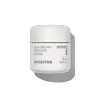What's inside
What's inside
 Key Ingredients
Key Ingredients

 Benefits
Benefits

 Concerns
Concerns

 Ingredients Side-by-side
Ingredients Side-by-side

Bifida Ferment Lysate
Skin ConditioningSaccharomyces Ferment Filtrate
HumectantBetula Alba Juice
AstringentRice Ferment Filtrate
Skin ConditioningWater
Skin ConditioningAspergillus Ferment
Skin ConditioningPropanediol
SolventPolyglyceryl-4 Caprate
Emulsifying1,2-Hexanediol
Skin ConditioningGlycereth-25 PCA Isostearate
EmulsifyingCamellia Sinensis Leaf Extract
AntimicrobialEthylhexylglycerin
Skin ConditioningSodium Lactate
BufferingSodium Gluconate
Skin ConditioningAllantoin
Skin ConditioningLactobacillus
Skin ConditioningDisodium EDTA
Tromethamine
BufferingMentha Piperita Oil
MaskingGluconolactone
Skin ConditioningSalicylic Acid
MaskingPanthenol
Skin ConditioningCapryloyl Salicylic Acid
ExfoliatingGlycolic Acid
BufferingButylene Glycol
HumectantHyaluronic Acid
HumectantHydrolyzed Hyaluronic Acid
HumectantSodium Hyaluronate
HumectantBifida Ferment Lysate, Saccharomyces Ferment Filtrate, Betula Alba Juice, Rice Ferment Filtrate, Water, Aspergillus Ferment, Propanediol, Polyglyceryl-4 Caprate, 1,2-Hexanediol, Glycereth-25 PCA Isostearate, Camellia Sinensis Leaf Extract, Ethylhexylglycerin, Sodium Lactate, Sodium Gluconate, Allantoin, Lactobacillus, Disodium EDTA, Tromethamine, Mentha Piperita Oil, Gluconolactone, Salicylic Acid, Panthenol, Capryloyl Salicylic Acid, Glycolic Acid, Butylene Glycol, Hyaluronic Acid, Hydrolyzed Hyaluronic Acid, Sodium Hyaluronate
Water
Skin ConditioningCyclopentasiloxane
EmollientPropanediol
SolventGlycerin
HumectantCyclohexasiloxane
EmollientPEG-10 Dimethicone
Skin ConditioningSqualane
EmollientNiacinamide
SmoothingDiphenylsiloxy Phenyl Trimethicone
Skin ConditioningDisteardimonium Hectorite
StabilisingSodium Chloride
Masking1,2-Hexanediol
Skin ConditioningLauryl PEG-9 Polydimethylsiloxyethyl Dimethicone
Skin ConditioningDimethicone
EmollientPolysilicone-11
Dimethicone/Vinyl Dimethicone Crosspolymer
Skin ConditioningParfum
MaskingGlyceryl Caprylate
EmollientEthylhexylglycerin
Skin ConditioningAdenosine
Skin ConditioningDisodium EDTA
Hyaluronic Acid
HumectantHexyl Cinnamal
PerfumingBetaine
HumectantLinalool
PerfumingDextrin
AbsorbentTheobroma Cacao Extract
Skin ConditioningGlucose
HumectantOrchid Extract
Skin ConditioningCI 77491
Cosmetic ColorantTocopherol
AntioxidantArginine/Lysine Polypeptide
Skin ConditioningWater, Cyclopentasiloxane, Propanediol, Glycerin, Cyclohexasiloxane, PEG-10 Dimethicone, Squalane, Niacinamide, Diphenylsiloxy Phenyl Trimethicone, Disteardimonium Hectorite, Sodium Chloride, 1,2-Hexanediol, Lauryl PEG-9 Polydimethylsiloxyethyl Dimethicone, Dimethicone, Polysilicone-11, Dimethicone/Vinyl Dimethicone Crosspolymer, Parfum, Glyceryl Caprylate, Ethylhexylglycerin, Adenosine, Disodium EDTA, Hyaluronic Acid, Hexyl Cinnamal, Betaine, Linalool, Dextrin, Theobroma Cacao Extract, Glucose, Orchid Extract, CI 77491, Tocopherol, Arginine/Lysine Polypeptide
 Reviews
Reviews

Ingredients Explained
These ingredients are found in both products.
Ingredients higher up in an ingredient list are typically present in a larger amount.
1,2-Hexanediol is a synthetic liquid and another multi-functional powerhouse.
It is a:
- Humectant, drawing moisture into the skin
- Emollient, helping to soften skin
- Solvent, dispersing and stabilizing formulas
- Preservative booster, enhancing the antimicrobial activity of other preservatives
Disodium EDTA plays a role in making products more stable by aiding other preservatives.
It is a chelating agent, meaning it neutralizes metal ions that may be found in a product.
Disodium EDTA is a salt of edetic acid and is found to be safe in cosmetic ingredients.
Learn more about Disodium EDTAEthylhexylglycerin (we can't pronounce this either) is commonly used as a preservative and skin softener. It is derived from glyceryl.
You might see Ethylhexylglycerin often paired with other preservatives such as phenoxyethanol. Ethylhexylglycerin has been found to increase the effectiveness of these other preservatives.
Hyaluronic acid is naturally found in healthy skin. It is a humectant, meaning it draws moisture to your skin.
This ingredient helps hydrate, soothe, and protect the skin.
What makes hyaluronic acid so hydrating? It has the capacity to bind or hold large amounts of water.
Fun fact: It is already naturally found in our bodies, such as the fluids of our eyes and our joints.
Studies find this ingredient to have anti-inflammatory and anti-microbial properties. This can help speed up wound-healing.
Hyaluronic acid can be irritating if the molecule has a low-molecular weight, or if the molecules are small.
One study found low-molecular weight hyaluronic acid to be pro-inflammatory, meaning some people may experience irritation. This is because our bodies use hyaluronic acid in the wound-healing process to signal to our bodies, via irritation, that something needs healing.
The same study found high-molecular weight hyaluronic acid to be anti-inflammatory.
These are some other common types of Hyaluronic Acid:
Learn more about Hyaluronic AcidPropanediol is an all-star ingredient. It softens, hydrates, and smooths the skin.
It’s often used to:
Propanediol is not likely to cause sensitivity and considered safe to use. It is derived from corn or petroleum with a clear color and no scent.
Learn more about PropanediolWater. It's the most common cosmetic ingredient of all. You'll usually see it at the top of ingredient lists, meaning that it makes up the largest part of the product.
So why is it so popular? Water most often acts as a solvent - this means that it helps dissolve other ingredients into the formulation.
You'll also recognize water as that liquid we all need to stay alive. If you see this, drink a glass of water. Stay hydrated!
Learn more about Water